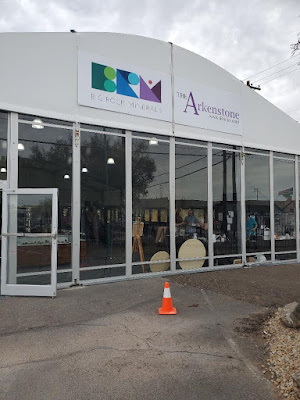To start off in this day of sheltering, the WORD OF THE DAY is
Alliteration: the repetition of identical initial consonant sounds in a group of words, words such as a SCHOONER OF SCHUETTEITE. No, the mineral does not come in a beer glass; however, at the time of this writing I was getting cabin fever and wished that I had a cold schooner of IPA.
Many rockhounds have a nice, bright red crystal of cinnabar, a mercury sulfide [HgS], in their collection (see Posting November 30, 2012), with many coming from recently opened localities in China. Cinnabar crystals are impressive if for nothing else than the brilliant color. Other collectors shy away from cinnabar as they fear absorbing mercury into their body. However, MinDat notes that mercury sulfide is relatively insoluble and generally safe to handle. However, do not inhale dust associated with the crystals and always wash hands after handling the specimens (that warning goes with essentially all minerals).
Mercury minerals were quite valuable during the various “gold rushes” to the western U.S. The minerals were heated to produce raw mercury which was then used to obtain fine-grained gold gathered from screening activities. It seems when raw mercury was mixed with the “fines” the result was the formation of an alloy called amalgam. This amalgam (gold plus mercury) was easy to separate from the other fines composed of heavy minerals such as iron minerals. The end product was a “hunk” of gray amalgam that was then heated in some sort of a retort pot allowing the mercury to evaporate; however, due to the difficulty of locating raw mercury most miners tried to catch the fumes in a condenser and cause the mercury to reprecipitate for another use. In most placer mining the process was much less than perfect and the mercury escaped into the atmosphere and water and pollution was rampant. Mercury seems to stick around “forever” and so the polluted water and soil remains. The miners who “cooked” the mercury also had a variety of health problems including losing their teeth.
Cinnabar is/was the major mercury producing ore while China and Kyrgyzstan are/were the last two countries mining ore. Most mercury today is produced as a byproduct of precious metal mining or recycled from previous mercury-containing products (many electrical switches).
Mercury has not been mined in the U.S. since 1992 with peak production in 1877. Major mining districts included the Terlingua District in Texas, and several districts in California and Nevada.
Schuetteite is an interesting mineral that is often found with cinnabar and chalcedony in old mercury mining districts in the arid deserts and ranges of the western United States. In the original description of schuetteite (Baily and others, 1959) noted that it was a common secondary alteration product found on: 1) dumps at old mercury mines; and 2) bricks from furnaces that refined mercury ore. In natural occurrences schuetteite, a mercury sulfate [Hg3O2(SO4)] formed by direct oxidation of cinnabar, a mercury sulfate (HgS), by oxygen-bearing surface water with sunlight providing the energy.
Schuetteite is identified by its yellow to yellow-orange color, its occurrence as very thin encrustations on cinnabar, a measured hardness of ~3 (Mohs), and if need be, an x-ray comparison with synthetic schuetteite. It can be confused with other mercury alteration products such as kleinite, a mercury oxychloride (see Posting November 24, 2019). However, kleinite and the others contain chlorine that causes the yellow mineral to darken in sunlight. Schuetteite does not contain chlorine and therefore retains the original yellow color.
 ` ` |
Thin, earthy, yellow, crusts of schuetteite surrounding tarnished cinnabar on an opalized matrix of rhyolite (or some other volcanic rock). Bottom photomicrograph width ~1.6 cm.; top 1.3 cm.
|
REFERENCES
CITED
Bailey, E.H., F.A. Hildebrand, C.L. Christ, and J.J. Fahey, 1959, Schuetteite, a new supergene mineral: American Mineralogist: Journal of Earth and Planetary Materials, v. 44, no. 9-10.
So, in this time of “sheltering in place” a little learning is a wonderful thing. But, my mind tends to wander and all of a sudden a tune from the past pops up.
Apologies to Hank Williams Jr.
Don’t
ask me,
Mike
why do you write?
Why
do you Blog?
Why must
you fuss about rocks that are bright?
If I’m
down in a honky-tonk
And
some dufus is given me friction
I’ll
say leave me alone
I’m
blogging all night long
It’s
a rockhound tradition.
OK, that was pretty sad! Sorry.




























